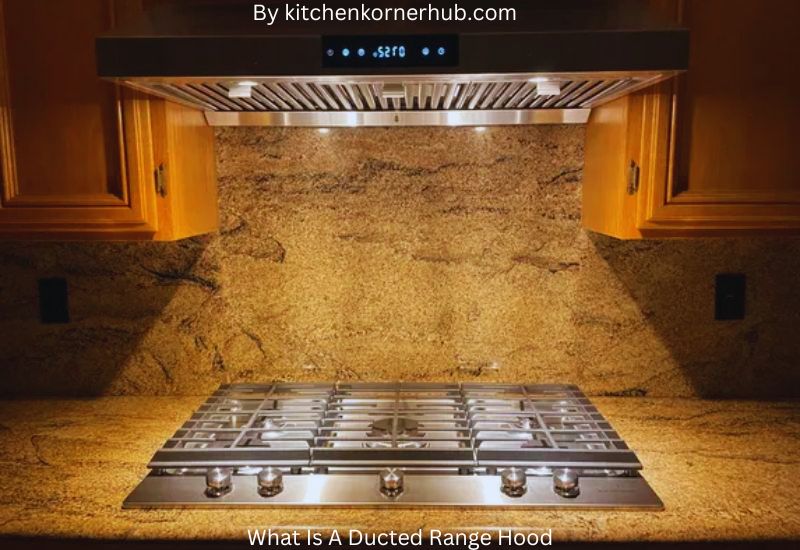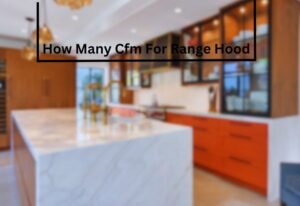A ducted range hood is a kitchen appliance designed to keep your cooking space fresh and odor-free. It acts like a superhero for your kitchen by capturing and eliminating the steam, smoke, and cooking odors that inevitably arise when you’re whipping up your favorite meals. This nifty device is usually installed above your stovetop, working diligently to suck up all the unwanted air particles and channel them out of your home through a series of ducts and vents.
What Is A Ducted Range Hood? A ducted range hood is a kitchen ventilation appliance installed above a cooktop or stove. It removes smoke, odors, and grease from cooking by using a system of ducts to expel the air outside. This helps maintain indoor air quality and prevents the buildup of pollutants in the kitchen area.
Unlike its counterpart, the ductless range hood, which recirculates the air after filtering, a ducted range hood vents the air outside, ensuring a more effective removal of the cooking byproducts. This not only keeps your kitchen atmosphere pleasant but also helps maintain better air quality throughout your home. Ducted range hoods come in various styles and sizes to match your kitchen’s aesthetics and needs, making them an essential addition to any cooking space.
Introduction to Ducted Range Hoods

The kitchen, often referred to as the heart of a home, is a space where culinary creativity flourishes. Cooking up aromatic and delicious dishes, however, can also generate a substantial amount of heat, steam, and airborne grease particles that can linger and create an unpleasant environment.
Ducted range hoods have emerged as an indispensable solution to address these concerns while maintaining a comfortable and clean cooking space.
Advantages of Ducted Range Hoods
Ducted range hoods, also known as vented range hoods, offer a range of advantages over their non-ducted counterparts. One of the primary benefits is their efficient removal of cooking byproducts.
By venting out the air to the outside through a series of ducts, these hoods effectively expel heat, steam, smoke, and grease particles, preventing them from accumulating on surfaces and leaving the air in your kitchen fresher and cleaner. This not only enhances your cooking experience but also maintains the longevity of your kitchen appliances.
Mechanism and Components
Ducted range hoods consist of several key components that work in tandem to ensure optimal performance. The main components include the hood itself, a fan, a grease filter, and a duct system.
As the fan draws in air from the cooking area, the grease filter captures grease particles, preventing them from entering the ductwork. The filtered air is then channeled through the ducts and expelled outside the home. This multi-step process ensures that both visible and invisible pollutants are effectively removed, improving air quality and reducing the risk of lingering odors.
Considerations for Installation
When installing a ducted range hood, there are several considerations to keep in mind. First, the placement of the hood plays a crucial role in its effectiveness. It should be positioned directly over the cooking area to capture pollutants at their source.
Additionally, the length and configuration of the ductwork must be carefully planned to maximize airflow and minimize resistance, ensuring efficient ventilation. Moreover, ensuring proper sealing along the ducts prevents air leaks and maintains the system’s efficiency.
Maintenance and Cleaning
Regular maintenance is essential to ensure the continued efficiency of a ducted range hood. Grease filters should be cleaned or replaced periodically to prevent buildup that can hinder airflow.
The ductwork should also be inspected for any blockages or damage that could impede proper ventilation. Professional cleaning services may be necessary in some cases to ensure thorough cleaning of the entire system.
How Ducted Range Hoods Work

The kitchen has long been the heart of a home, where culinary creations come to life, but it’s also a space where cooking byproducts like smoke, steam, and odors can accumulate. Ducted range hoods, a key component of modern kitchens, play a crucial role in maintaining a healthy and comfortable cooking environment.
These appliances are designed to effectively remove airborne particles and unwanted odors, thereby improving indoor air quality. Understanding how ducted range hoods work can provide valuable insight into their role in maintaining a pleasant kitchen environment.
Mechanism of Operation: Suction and Extraction
Ducted range hoods operate on a simple yet effective principle of suction and extraction. A powerful fan, usually located inside the hood unit, draws in air from the cooking area.
This airflow carries with it a mix of particles, including grease, smoke, steam, and odors. The contaminated air is then directed through a series of filters that capture and trap these particles. Finally, the purified air is expelled outside the home through a duct system, effectively removing the pollutants from the kitchen space.
Components of Ducted Range Hoods
These hoods consist of several essential components that work in harmony to achieve optimal air purification. The primary components include the fan, filters, and the duct system. The fan is the heart of the operation, creating the necessary airflow to draw in and expel air.
Filters, often composed of aluminum mesh and activated charcoal, play a pivotal role in capturing and neutralizing particles and odors. The duct system, connecting the hood to the exterior, ensures the filtered air is directed out of the home, preventing recirculation of contaminants.
Filter Varieties for Enhanced Efficiency
Ducted range hoods utilize different types of filters to effectively address varying types of pollutants. Aluminum mesh filters are the first line of defense, capturing larger particles such as grease.
For finer particles and odors, activated charcoal filters come into play. These filters contain a porous carbon material that adsorbs and eliminates odorous molecules. Regular maintenance, including cleaning or replacement of filters, is crucial to sustaining the appliance’s efficiency over time.
Importance of Proper Sizing and Placement
The effectiveness of a ducted range hood is contingent on its size and proper placement above the cooking area. Selecting a hood that matches the dimensions of the cooking space and has an appropriate fan power ensures maximum airflow and particle removal.
Correct installation height is also essential; a hood placed too high may lead to inadequate pollutant capture, while a hood placed too low could obstruct the cook’s view and movements.
Benefits Beyond Air Quality
While the primary function of ducted range hoods is to improve air quality, they offer additional benefits as well. By removing excess heat and steam generated during cooking, these hoods help maintain a comfortable kitchen temperature.
Moreover, they contribute to preserving the longevity of kitchen appliances and cabinetry by preventing the accumulation of grease and moisture. In this way, ducted range hoods not only enhance the cooking environment but also contribute to the overall maintenance of the kitchen space.
Advantages of Ducted Range Hoods

A ducted range hood is a kitchen appliance that offers a range of benefits for homeowners seeking efficient ventilation and a healthier cooking environment. This article explores several advantages of using ducted range hoods, highlighting their superiority over their non-ducted counterparts.
Superior Smoke and Odor Removal:
Ducted range hoods excel in removing smoke, steam, and strong cooking odors from the kitchen. Unlike ductless hoods, which merely recirculate air through filters, ducted hoods expel these pollutants outside the house through a vent.
This feature is particularly valuable when cooking pungent dishes like fish or frying foods, as it ensures that the odors don’t linger and spread throughout the home.
Effective Grease Filtration:
One of the primary functions of a range hood is to capture grease particles generated during cooking. Ducted range hoods employ grease filters that trap these particles before they have a chance to settle on kitchen surfaces or circulate through the air.
These filters are generally more efficient and require less frequent cleaning compared to the filters used in ductless hoods. This not only keeps the kitchen cleaner but also reduces the risk of grease-related fire hazards.
Enhanced Air Quality:
Using a ducted range hood significantly improves indoor air quality. Cooking releases various pollutants, including carbon monoxide, volatile organic compounds (VOCs), and particulate matter.
Ducted hoods swiftly remove these contaminants from the kitchen environment, helping to maintain a healthier indoor atmosphere for both the residents and the house itself.
Reduced Heat Buildup:
Intense cooking can raise the temperature in the kitchen, making it uncomfortable for chefs and increasing the load on cooling systems.
Ducted range hoods play a role in dissipating heat by pulling hot air and steam away from the cooking area. This not only keeps the kitchen cooler but also contributes to energy savings, as air conditioners don’t need to work as hard to maintain a comfortable temperature.
Quieter Operation:
Ducted range hoods tend to operate more quietly compared to ductless models. The ducting system helps muffle the noise generated by the fan and the airflow, creating a more peaceful cooking environment. This can be especially advantageous in open-concept kitchens where noise easily carries, or in homes where a quieter atmosphere is preferred.
Comparing Ducted and Ductless Range Hoods: Pros and Cons

In the realm of kitchen appliances, range hoods play a crucial role in maintaining air quality, managing odors, and preventing grease buildup.
When choosing between ducted and ductless range hoods, homeowners must weigh the advantages and disadvantages of each option to make an informed decision that suits their specific needs.
Ducted Range Hoods: Enhanced Performance and Efficiency
Ducted range hoods, also known as vented range hoods, are designed to extract cooking fumes and airborne particles directly outside the house through a duct system. One of the primary advantages of ducted range hoods is their superior performance in terms of air filtration and ventilation.
By expelling pollutants outdoors, these hoods effectively reduce indoor air pollutants, including grease, steam, and strong odors. This ensures a cleaner and more comfortable cooking environment, particularly when dealing with high-heat cooking methods or frequent cooking.
However, the installation of ducted range hoods requires a ventilation system, which may not be feasible in all kitchen layouts.
Additionally, installation can be more complex and expensive, as it involves routing the ductwork through walls, ceilings, or cabinets. Despite these potential challenges, the long-term benefits of improved air quality and efficient ventilation often outweigh the initial installation difficulties.
Ductless Range Hoods: Flexibility and Simplicity
Ductless range hoods, also known as recirculating range hoods, operate by filtering cooking fumes through a series of filters before recirculating the purified air back into the kitchen.
One of the primary advantages of ductless range hoods is their flexibility in installation. They can be easily installed in kitchens where ductwork is not feasible, making them suitable for apartments or homes with unconventional layouts.
Ductless range hoods are generally more straightforward to install since they don’t require complex ductwork. This simplicity translates to reduced installation costs and less disruption to the kitchen during the installation process. However, while ductless range hoods are effective at capturing grease and odors, they might not be as efficient at eliminating smoke and steam compared to their ducted counterparts.
Noise Levels and Performance
Noise levels are an important consideration when comparing ducted and ductless range hoods. Ducted range hoods tend to be quieter during operation because the noise produced by the fan is carried away through the ductwork to the outside.
On the other hand, ductless range hoods use internal fans to recirculate air, which can lead to higher noise levels in the kitchen. However, advancements in technology have led to quieter models of both types of range hoods, providing homeowners with options that prioritize both performance and minimal noise.
Maintenance and Filter Replacement
Maintenance is another crucial aspect to consider. Ducted range hoods typically have removable grease filters that need regular cleaning or replacement. However, ductless range hoods require more frequent filter replacement since they rely on filtering the air before recirculating it.
These filters capture grease and odors, and their replacement frequency depends on cooking frequency and the type of cooking being done. Homeowners should factor in the ongoing maintenance costs when deciding between the two options.
Energy Efficiency and Environmental Impact
In terms of energy efficiency and environmental impact, ducted range hoods are generally more efficient since they expel air directly outside, reducing the need for additional air conditioning or heating to compensate for the ventilation.
Ductless range hoods, on the other hand, consume energy to operate their internal fans and filters. However, advancements in filter technology and energy-efficient fans have made ductless range hoods more environmentally friendly over time.
Conclusion
In conclusion, a ducted range hood stands as an indispensable appliance in modern kitchens, effectively tackling the challenges of smoke, odors, and grease during cooking. Its ability to vent these byproducts outside ensures a cleaner, more comfortable cooking environment. By extracting and filtering the air, ducted range hoods promote healthier indoor air quality. Additionally, their variety in design and functionality allows homeowners to select a model that aligns with their kitchen layout and personal preferences. Overall, the incorporation of a ducted range hood exemplifies a practical and aesthetic enhancement, contributing to a more enjoyable and efficient culinary experience.
Frequently Asked Question(What Is A Ducted Range Hood)
Are ducted range hoods better?
Ducted range hoods are generally considered to be more effective at removing cooking odors, smoke, and grease from your kitchen compared to non-ducted or recirculating hoods.
They work by venting the air and pollutants outside your home through a duct system.
This process helps maintain better indoor air quality and prevents the recirculation of contaminants back into your living space.
How do I know if my range hood is ducted?
To determine if your range hood is ducted, you can usually check the installation setup. If your range hood is connected to a duct that leads to the outside of your home, it’s ducted.
You might find an exhaust duct on the exterior wall of your house corresponding to the location of the range hood.
Additionally, ducted range hoods often have removable grease filters that can be easily accessed for cleaning, as opposed to non-ducted hoods that may have charcoal filters for recirculating air.
What are the benefits of a ducted range hood?
Ducted range hoods offer several benefits, primarily due to their efficient ventilation process. They effectively remove cooking byproducts like smoke, steam, and odors from your kitchen, keeping the air fresh and free from contaminants.
Ducted range hoods are particularly advantageous for kitchens with high cooking activity or strong-smelling dishes. They also help prevent the accumulation of grease on surfaces and cabinets, contributing to easier cleaning and maintenance.
What is the difference between converted and ducted range hood?
The main difference between a converted (non-ducted or recirculating) and a ducted range hood lies in how they handle the air they collect. Ducted range hoods vent the air to the outside through a duct system, effectively expelling pollutants from your kitchen and home.
On the other hand, converted range hoods recirculate the air back into the kitchen after passing it through filters that primarily capture grease and some odors. While converted hoods are more straightforward to install and are suitable for kitchens without access to exterior ducting, ducted hoods tend to be more efficient in maintaining air quality by expelling contaminants outdoors.
Which type of cooker hood is better?
When it comes to choosing the right cooker hood, the best choice depends on your specific needs and kitchen setup. There are mainly two types of cooker hoods: ducted (or vented) and recirculating (or non-vented). Each has its advantages and drawbacks.
Ducted cooker hoods are typically considered better for efficient ventilation because they expel cooking odors and grease outside your home through a duct. They work by sucking in the air, filtering out impurities, and then venting it outside. This type is excellent for those who cook frequently and want optimal odor and grease removal. However, it requires proper installation with an external duct, which may not be feasible in every kitchen.
What are the three types of ventilation hood?
On the other hand, recirculating cooker hoods are more flexible when it comes to installation since they don’t need an external duct. Instead, they use filters to trap grease and odors, then recirculate the clean air back into the kitchen. While they are easier to install, they are generally considered less effective in eliminating cooking smells and grease compared to ducted hoods. So, if you don’t cook very often or if duct installation is challenging, a recirculating hood might be more suitable.
Additionally, there is a third type known as island cooker hoods. These are specially designed for kitchens with cooktops on an island, away from the wall. Island hoods are typically larger and more powerful to effectively capture and remove smoke and odors from the open kitchen space. They can be either ducted or recirculating, depending on your kitchen layout and preferences.




